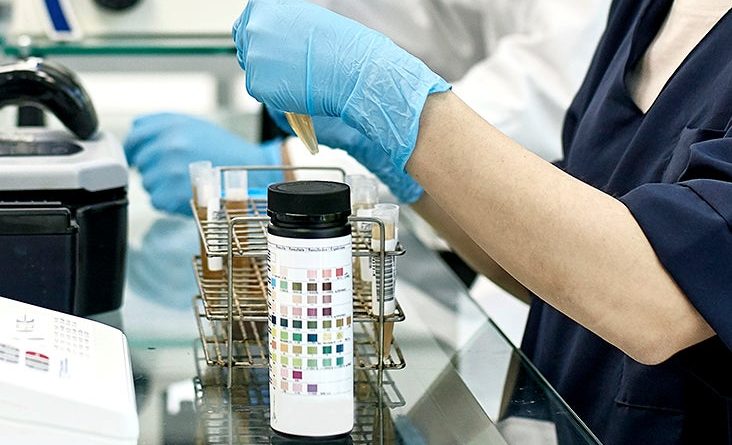Pancreatic and prostate cancer: Simple urine test may aid diagnosis

- Pancreatic cancer accounted for 3.2%, and prostate cancer accounted for 14.2% of all new cancer cases in 2022 in the United States.
- Pancreatic cancer, in particular, can be difficult to treat and has a much higher mortality rate than many forms of cancer, what may be due to the fact it is often diagnosed late.
- Korean researchers recently devised a way to detect both pancreatic and prostate cancer with a urine test.
- With pancreatic cancer on the rise in younger women, this technology may provide a route to earlier cancer detection and treatment.
Early detection of cancer is very important to successful treatment and improving a patient’s prognosis. As such, researchers continue looking for ways to improve on detection of various forms of cancer.
A team led by researchers from the Surface & Nano Materials Division of the Korea Institute of Materials Science recently published a study in Biosensors and Bioelectronics showing a new way to detect pancreatic and prostate cancer using a urine test.
They say the test can have up to a 99% detection rate.
Pancreatic and prostate cancer
Pancreatic and prostate cancer affect millions of people in the U.S.. The American Cancer Society estimates that approximately 64,000 people will receive a pancreatic cancer diagnosis in 2023 and that around 288,000 people will receive a prostate cancer diagnosis in 2023.
Some signs and symptoms of pancreatic cancer include:
- jaundice
- indigestion
- nausea and vomiting
- pale gray or fatty stool
Unfortunately, pancreatic cancer is generally only detected in later stages, and the death rates with this form of cancer are high. The 5-year survival rate for pancreatic cancer is 12%.
Additionally, pancreatic cancer rates are increasing in the U.S. each year and are increasing at faster rates in younger women, particularly in Black women. A recent study showed that pancreatic cancer rates in Black women under age 55 rose 2.23% compared to Black men of the same age group.
The 5-year survival rate for prostate cancer is 97%. With the exception of skin cancer, prostate cancer is the most common cancer in men, and 1 in 8 men receive a diagnosis throughout their lifetime.
Not all men experience symptoms of prostate cancer, but doctors can detect it through routine screening. However, for men who do experience symptoms, some of those may include frequent urination and painful urination.
Current testing and screening for either pancreatic or prostate cancer can be rather invasive and sometimes expensive.
Some ways doctors test for pancreatic cancer include utilizing CT and MRI scans, and for prostate cancer testing, doctors use blood testing, transrectal ultrasounds, or rectal exams.
Creating a cancer-detecting urine test
Since biofluids can be instrumental in detecting or diagnosing certain conditions, the researchers in this study wanted to utilize these in a more advanced way—by using urine to detect cancer metabolites.
“Urine is a promising biofluid for disease diagnosis because most metabolic components are excreted via the urinary tract,” write the authors.
The researchers note that prior studies show that the metabolite compounds present in urine are different in urine of people without cancer versus the urine of people with cancer, but that previously, the only way to detect those compounds was through a “laborious” process.
By developing an enhanced Surface-enhanced Raman scattering (SERS) sensor, the scientists were able to detect “hot spots” in urine samples. These hot spots picked up and amplified certain molecular compounds that point toward cancer.
After creating a urine test strip and a handheld testing machine, the researchers obtained urine samples from a number of patients with pancreatic or prostate cancer to see how well the test functioned.
In addition to obtaining urine samples from 19 patients with pancreatic cancer and 39 patients with prostate cancer, the researchers collected samples from 40 cancer-free males and 20 cancer-free females.
The test was overall able to detect 99% of the cancerous samples.
Detecting cancer earlier?
“Since early diagnosis is the most important for incurable diseases such as cancer, we expect this technology to provide a new diagnostic method,” says study author and research lead Ho Sang Jung, who is in charge of the research.
Dr. Domenech Asbun, a hepatobiliary, pancreas, and foregut surgeon at Miami Cancer Institute, part of Baptist Health South Florida, spoke with Medical News Today about the study.
“The authors use an interesting combination of technology—including established complex physics and cutting-edge deep learning models—in attempts to solve a long-standing problem: how do we diagnose occult cancers in the general population before it’s too late?” he said.
“The findings in this study may provide an important step forward in finding practical ways to diagnose cancers that oftentimes grow undetected. If the results can be reproduced on a larger scale, these tests may allow for early treatment of cancers that are quite often deadly when undetected for too long.”
— Dr. Domenech Asbun
The future of this technology
Jung spoke with Medical News Today about the future of this research and said they are expanding on it by testing more subjects.
“The number of patients tested using our system is continuously growing. Our team is trying to get as many clinical samples as possible to build more general deep-learning models with better accuracy,” said Jung.
Jung also said they want to be able to test for more than just two types of cancer.
“The next step in this research is broadening applicable cancer types. Now, our team just finished testing clinical samples of pancreatic cancer, prostate cancer, lung cancer, and colorectal cancer simultaneously, and our team is expected to submit an article this year.”
In addition to expanding on cancer types, Jung says they envision at-home testing kits in the future.
“Because the developed diagnostic method uses urine, it is noninvasive thus it would be more beneficial in terms of usability when it is applied for self-testing or rapid-kit-testing at home, pharmacy, or any places where they can provide some clinical information.”
— Ho Sang Jung, study author
Source: Read Full Article



